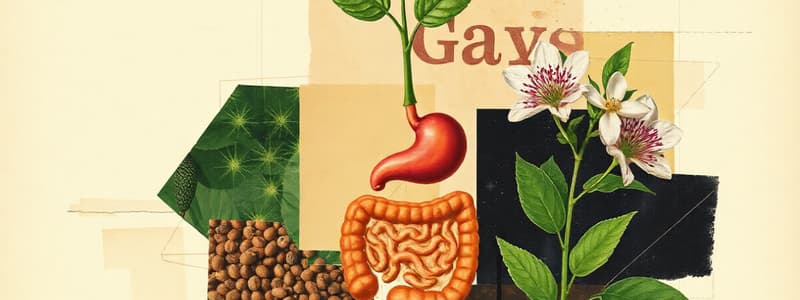Podcast
Questions and Answers
What disorder results from undigested food passing too quickly through the large intestine?
What disorder results from undigested food passing too quickly through the large intestine?
- Piles
- Food poisoning
- Constipation
- Diarrhea (correct)
What term describes the movement of nutrients across the gastrointestinal tract epithelium into the blood and lymphatic vessels?
What term describes the movement of nutrients across the gastrointestinal tract epithelium into the blood and lymphatic vessels?
- Absorption (correct)
- Ingestion
- Digestion
- Secretion
Which nutrient deficiency causes yellow and brown leaf margins leading to plant death?
Which nutrient deficiency causes yellow and brown leaf margins leading to plant death?
- Potassium
- Magnesium (correct)
- Phosphorus
- Iron
Which mode of respiration is utilized by mammals?
Which mode of respiration is utilized by mammals?
Which structure does not aid in the process of breathing in humans?
Which structure does not aid in the process of breathing in humans?
Where is oxyhemoglobin primarily formed in the body?
Where is oxyhemoglobin primarily formed in the body?
What maintains the openness of the trachea?
What maintains the openness of the trachea?
What substance increase the breathing rate when present in higher concentrations in the blood?
What substance increase the breathing rate when present in higher concentrations in the blood?
Which salivary gland is responsible for secreting amylase?
Which salivary gland is responsible for secreting amylase?
Identify the structure which is commonly associated with producing the enzyme pepsinogen.
Identify the structure which is commonly associated with producing the enzyme pepsinogen.
Which of the following processes is primarily involved in the movement of food along the gastrointestinal tract?
Which of the following processes is primarily involved in the movement of food along the gastrointestinal tract?
In which part of the digestive system does the main digestion of proteins occur?
In which part of the digestive system does the main digestion of proteins occur?
What is the primary function of bile in digestion?
What is the primary function of bile in digestion?
Which option represents the end products of protein digestion?
Which option represents the end products of protein digestion?
What is the approximate pH level of gastric juice in the stomach?
What is the approximate pH level of gastric juice in the stomach?
Which structure in the digestive system is primarily responsible for chyle formation?
Which structure in the digestive system is primarily responsible for chyle formation?
Maximally CO2 is transferred through blood in which form?
Maximally CO2 is transferred through blood in which form?
Which one of the following is not a part of the blood circulatory system?
Which one of the following is not a part of the blood circulatory system?
Which structure prevents the entry of food into the windpipe?
Which structure prevents the entry of food into the windpipe?
Which one of the following is included in agranulocytes?
Which one of the following is included in agranulocytes?
C-shaped cartilaginous rings supporting the trachea are primarily made of which type of cartilage?
C-shaped cartilaginous rings supporting the trachea are primarily made of which type of cartilage?
Respiratory distress syndrome is most commonly seen in which group?
Respiratory distress syndrome is most commonly seen in which group?
In embryonic life, red blood cells are formed in which location?
In embryonic life, red blood cells are formed in which location?
Least blood pressure is found in which part of the circulatory system?
Least blood pressure is found in which part of the circulatory system?
At an oxygen tension of 115 mm of mercury, what would be the hemoglobin saturation level?
At an oxygen tension of 115 mm of mercury, what would be the hemoglobin saturation level?
All of the following statements about white blood cells are true except:
All of the following statements about white blood cells are true except:
Which statement regarding gas diffusion is incorrect?
Which statement regarding gas diffusion is incorrect?
The cells of the heart are primarily nourished by which vessels?
The cells of the heart are primarily nourished by which vessels?
How much CO2 is contained in 100 ml of arterial blood in a human being?
How much CO2 is contained in 100 ml of arterial blood in a human being?
The thoracic duct is part of which system?
The thoracic duct is part of which system?
The ionic mechanism involved in the opening and closing of stomata primarily includes which ion?
The ionic mechanism involved in the opening and closing of stomata primarily includes which ion?
Plasma cells are formed by the differentiation of which cells?
Plasma cells are formed by the differentiation of which cells?
Flashcards
Digestion
Digestion
The process of breaking down food into smaller molecules that can be absorbed by the body.
Pancreatic juice
Pancreatic juice
The watery fluid secreted by the pancreas that contains enzymes for digesting carbohydrates, proteins, and fats.
Amylase
Amylase
The enzyme produced by the salivary glands that breaks down carbohydrates into simpler sugars.
Peristalsis
Peristalsis
Signup and view all the flashcards
Assimilation
Assimilation
Signup and view all the flashcards
Chyle
Chyle
Signup and view all the flashcards
Respiration
Respiration
Signup and view all the flashcards
Pepsinogen
Pepsinogen
Signup and view all the flashcards
Diarrhea
Diarrhea
Signup and view all the flashcards
Absorption
Absorption
Signup and view all the flashcards
Magnesium Deficiency
Magnesium Deficiency
Signup and view all the flashcards
Pulmonary Respiration
Pulmonary Respiration
Signup and view all the flashcards
Diaphragm
Diaphragm
Signup and view all the flashcards
Oxyhemoglobin
Oxyhemoglobin
Signup and view all the flashcards
Cartilage
Cartilage
Signup and view all the flashcards
Medulla Oblongata
Medulla Oblongata
Signup and view all the flashcards
CO2 transport
CO2 transport
Signup and view all the flashcards
What prevents food from entering the windpipe?
What prevents food from entering the windpipe?
Signup and view all the flashcards
What type of cartilage makes up the trachea's rings?
What type of cartilage makes up the trachea's rings?
Signup and view all the flashcards
Respiratory distress syndrome: who is it common in?
Respiratory distress syndrome: who is it common in?
Signup and view all the flashcards
Hemoglobin saturation at 115 mm Hg
Hemoglobin saturation at 115 mm Hg
Signup and view all the flashcards
Which statement about gas diffusion is incorrect?
Which statement about gas diffusion is incorrect?
Signup and view all the flashcards
How much CO2 is in 100 ml of arterial blood?
How much CO2 is in 100 ml of arterial blood?
Signup and view all the flashcards
What is the main health risk linked to tar in tobacco smoke?
What is the main health risk linked to tar in tobacco smoke?
Signup and view all the flashcards
What is not part of the blood circulatory system?
What is not part of the blood circulatory system?
Signup and view all the flashcards
Agranulocytes
Agranulocytes
Signup and view all the flashcards
Where are red blood cells formed in the embryo?
Where are red blood cells formed in the embryo?
Signup and view all the flashcards
Where is blood pressure the lowest?
Where is blood pressure the lowest?
Signup and view all the flashcards
All about white blood cells is true except...
All about white blood cells is true except...
Signup and view all the flashcards
What nourishes the heart?
What nourishes the heart?
Signup and view all the flashcards
What is the thoracic duct a part of?
What is the thoracic duct a part of?
Signup and view all the flashcards
What do plasma cells differentiate from?
What do plasma cells differentiate from?
Signup and view all the flashcards
Study Notes
Life Processes in Animals & Plants (Nutrition, Gaseous Exchange & Transport)
-
Plant Nutrition (Examples): Pitcher plant (Drosera intermedia)
-
Digestive System:
- Stomach: Stores food, mechanical digestion (churning), digests proteins, produces HCl, pH ~3-4
- Secretions: Saliva (no amylase in some types); pancreatic juice; bile; intestinal juice (digestion of proteins, lipids, carbohydrates).
- Intestinal digestion of proteins: amino acids
- End products of protein digestion: Amino acids; some peptides
- Digestion occurs in the small intestine and rectum.
- Chyle is formed in the small intestine (absorption of fat).
-
Digestive Enzymes: Pepsinogen (stomach). Mucous cells, Parietal cells (stomach).
- Other enzymes that digest proteins: only pancreatic juice
-
Salivary glands: Parotid glands, submandibular glands, sublingual glands
-
Stomach location: Located in front of the ears.
-
Food passage through large intestine: Undigested food passing too quickly through = Diarrhea, excessive water loss
-
Absorption: Movement of digestive products, electrolytes, vitamins, and water across the gut epithelium
-
Breathing:
- Parts that contribute: Ribs, Larynx, Diaphragm
-
Respiratory rate control: Medulla oblongata (part of the brain)
-
Respiratory rate increase: Increase in carbon monoxide in the blood
-
Respiratory Structures: Alveoli (functional unit of lungs).
-
Respiratory Transport: Oxygen binding with hemoglobin influenced by temperature, CO2 levels, pH and oxygen levels (pO2).
-
pH in the body: affect Oxygen binding with hemoglobin (oxygen saturation)
-
Respiratory Gases: CO2 is transported in blood (as bicarbonate and carbaminohemoglobin)
-
Blood Cells and Functions:
- Red blood cells: formed in red bone marrow, important function of oxygen transport
- White blood cells (agranulocytes): lymphocytes (example)
- Leukocytes: Function in immunity
- White blood cells location of creation: bone marrow (including red bone marrow).
-
Blood Circulation:
- Nutrients, oxygen, and waste exchanged in blood vessels (arteries, capillaries, veins)
-
Tar in tobacco smoke associated with: Cancer
-
Plant Defenses: Soil deficiencies (e.g., phosphorus) can cause yellow/brown leaf margins.
-
Gas Exchange Mechanisms: Breathing; gaseous exchange at the lungs
-
Blood circulation and components: Blood vessels (arteries, capillaries, veins). Blood - including white blood cells, blood components.
-
Circulatory System (Components): Heart, blood vessels, blood
- Blood components: red blood cells, white blood cells (e.g., lymphocytes).
- Blood cells location of creation: red bone marrow, or lymph nodes.
-
Other: (From the questions, but not completely categorized)
- Trachea: kept open by cartilage rings
- Uvula function: Preventing food from entering the windpipe (trachea).
- Epiglottis function: Prevents food from entering the windpipe (trachea).
- Cartilage types: hyaline, elastic, fibrous, calcified
- Respiration modes: cutaneous, pulmonary
-
Immunity:
- Vaccination: artificial active immunity, natural active immunity, passive immunity
- Blood clotting: part of defense mechanism (physical barrier).
- Thymus gland: involved in maturation of T-lymphocytes
- Immune system (general): cells and functions associated with the immune system.
Studying That Suits You
Use AI to generate personalized quizzes and flashcards to suit your learning preferences.




